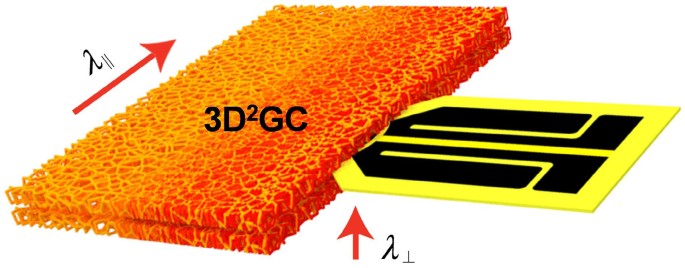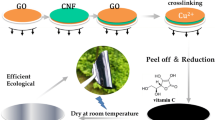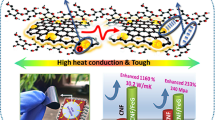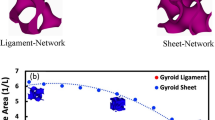Abstract
In the endeavor to develop three-dimensional (3D)-architected sophisticated hierarchical structures, the synergy between in-plane and out-of-plane interactions at interfaces offers new functionalities. This interplay, governed by van der Waals (vdW) interfacial nanoarchitectonics, facilitates the design of efficient thermally conductive pathways. This work delves into the kinetics underlying a dual-templating strategy, seamlessly integrating two-dimensional (2D)-graphene sheets with one-dimensional (1D)-cellulose chains at heterointerfaces, thereby transforming into 3D-shaped and 3D-continuously anisotropic structures, termed as (3D2GC) architecture. Hereby, we designed and fabricated an anisotropic graphene cellulose scaffold (GCS) employing a nickel template. The as-grown GCS replicates the 3D-shaped and configuration of the template. The 3D-continuously interconnected fibrous-porous network of the GCS, combined with its anisotropic thermal properties (λaxial/λradial), not only is promising for advanced thermal technologies but also offers advantages in cost-effectiveness and eco-effectiveness.

Similar content being viewed by others
References
Ariga, K. Nanoarchitectonics: What’s coming next after nanotechnology. Nanoscale Horiz. 2021, 6, 364–378.
Brisebois, P. P.; Siaj, M. Harvesting graphene oxide-years 1859 to 2019: A review of its structure, synthesis, properties and exfoliation. J. Mater. Chem. C 2020, 8, 1517–1547.
Foster, E. J.; Moon, R. J.; Agarwal, U. P.; Bortner, M. J.; Bras, J.; Camarero-Espinosa, S.; Chan, K. J.; Clift, M. J. D.; Cranston, E. D.; Eichhorn, S. J. et al. Current characterization methods for cellulose nanomaterials. Chem. Soc. Rev. 2018, 47, 2609–2679.
Shao, G. F.; Hanaor, D. A. H.; Shen, X. D.; Gurlo, A. Freeze casting: From low-dimensional building blocks to aligned porous structures—A review of novel materials, methods, and applications. Adv. Mater. 2020, 32, 1907176.
Wicklein, B.; Kocjan, A.; Salazar-Alvarez, G.; Carosio, F.; Camino, G.; Antonietti, M.; Bergström, L. Thermally insulating and fire-retardant lightweight anisotropic foams based on nanocellulose and graphene oxide. Nat. Nanotechnol. 2015, 10, 277–283.
Zhan, J.; Lei, Z. D.; Zhang, Y. Non-covalent interactions of graphene surface: Mechanisms and applications. Chem 2022, 8, 947–979.
Pérez, E. M.; Martín, N. π–π interactions in carbon nanostructures. Chem. Soc. Rev. 2015, 44, 6425–6433.
Lee, H.; Son, N.; Jeong, H. Y.; Kim, T. G.; Bang, G. S.; Kim, J. Y.; Shim, G. W.; Goddeti, K. C.; Kim, J. H.; Kim, N. et al. Friction and conductance imaging of sp2- and sp3-hybridized subdomains on single-layer graphene oxide. Nanoscale 2016, 8, 4063–4069.
Silvestre, G. H.; De Lima, F. C.; Bernardes, J. S.; Fazzio, A.; Miwa, R. H. Nanoscale structural and electronic properties of cellulose/graphene interfaces. Phys. Chem. Chem. Phys. 2023, 25, 1161–1168.
Thakur, V.; Guleria, A.; Kumar, S.; Sharma, S.; Singh, K. Recent advances in nanocellulose processing, functionalization and applications: A review. Mater. Adv. 2021, 2, 1872–1895.
Chandler, D.; Weeks, J. D.; Andersen, H. C. van der Waals picture of liquids, solids, and phase transformations. Science 1983, 220, 787–794.
Ariga, K.; Matsumoto, M.; Mori, T.; Shrestha, L. K. Materials nanoarchitectonics at two-dimensional liquid interfaces. Beilstein J. Nanotechnol. 2019, 10, 1559–1587.
Georgakilas, V.; Otyepka, M.; Bourlinos, A. B.; Chandra, V.; Kim, N.; Kemp, K. C.; Hobza, P.; Zboril, R.; Kim, K. S. Functionalization of graphene: Covalent and non-covalent approaches, derivatives and applications. Chem. Rev. 2012, 112, 6156–6214.
Jarvis, M. C. Hydrogen bonding and other non-covalent interactions at the surfaces of cellulose microfibrils. Cellulose 2023, 30, 667–687.
Verma, C.; Ebenso, E. E. Ionic liquid-mediated functionalization of graphene-based materials for versatile applications: A review. Graphene Technol. 2019, 4, 1–15.
Feng, L.; Chen, Z. L. Research progress on dissolution and functional modification of cellulose in ionic liquids. J. Mol. Liq. 2008, 142, 1–5.
Alqus, R.; Eichhorn, S. J.; Bryce, R. A. Molecular dynamics of cellulose amphiphilicity at the graphene–water interface. Biomacromolecules 2015, 16, 1771–1783.
Jahandideh, H.; Macairan, J. R.; Bahmani, A.; Lapointe, M.; Tufenkji, N. Fabrication of graphene-based porous materials: Traditional and emerging approaches. Chem. Sci. 2022, 13, 8924–8941.
Peng, H. D.; Meng, L. J.; Niu, L.; Lu, Q. H. Simultaneous reduction and surface functionalization of graphene oxide by natural cellulose with the assistance of the ionic liquid. J. Phys. Chem. C 2012, 116, 16294–16299.
Chen, Z. P.; Ren, W. C.; Gao, L. B.; Liu, B. L.; Pei, S. F.; Cheng, H. M. Three-dimensional flexible and conductive interconnected graphene networks grown by chemical vapour deposition. Nat. Mater. 2011, 10, 424–428.
** nanocellulose nets around graphene oxide sheets. Angew. Chem., Int. Ed. 2018, 57, 8508–8513.
Kudin, K. N.; Ozbas, B.; Schniepp, H. C.; Prud’homme, R. K.; Aksay, I. A.; Car, R. Raman spectra of graphite oxide and functionalized graphene sheets. Nano Lett. 2008, 8, 36–41.
Georgakilas, V.; Tiwari, J. N.; Kemp, K. C.; Perman, J. A.; Bourlinos, A. B.; Kim, K. S.; Zboril, R. Noncovalent functionalization of graphene and graphene oxide for energy materials, biosensing, catalytic, and biomedical applications. Chem. Rev. 2016, 116, 5464–5519.
Pernot, G.; Stoffel, M.; Savic, I.; Pezzoli, F.; Chen, P.; Savelli, G.; Jacquot, A.; Schumann, J.; Denker, U.; Mönch, I. et al. Precise control of thermal conductivity at the nanoscale through individual phonon-scattering barriers. Nat. Mater. 2010, 9, 491–495.
Kapitza, P. L. The study of heat transfer in helium II. J. Phys. (Moscow) 1941, 4, 181.
Kreith, F.; Black, W. Z. Basic Heat Transfer; Harper & Row: New York, 1980.
Li, T.; Song, J. W.; Zhao, X. P.; Yang, Z.; Pastel, G.; Xu, S. M.; Jia, C.; Dai, J. Q.; Chen, C. J.; Gong, A. et al. Anisotropic, lightweight, strong, and super thermally insulating nanowood with naturally aligned nanocellulose. Sci. Adv. 2018, 4, eaar3724.
Jiao, D. J.; Song, N.; Ding, P.; Shi, L. Y. Enhanced thermal conductivity in oriented cellulose nanofibril/graphene composites via interfacial engineering. Composit. Commun. 2022, 31, 101101.
Song, N.; Jiao, D. J.; Cui, S. Q.; Hou, X. S.; Ding, P.; Shi, L. Y. Highly anisotropic thermal conductivity of layer-by-layer assembled nanofibrillated cellulose/graphene nanosheets hybrid films for thermal management. ACS Appl. Mater. Interfaces 2017, 9, 2924–2932.
Cui, S. Q.; Song, N.; Shi, L. Y.; Ding, P. Enhanced thermal conductivity of bioinspired nanofibrillated cellulose hybrid films based on graphene sheets and nanodiamonds. ACS Sustainable Chem. Eng. 2020, 8, 6363–6370.
Balandin, A. A.; Ghosh, S.; Bao, W. Z.; Calizo, I.; Teweldebrhan, D.; Miao, F.; Lau, C. N. Superior thermal conductivity of single-layer graphene. Nano Lett. 2008, 8, 902–907.
Ma, H.; Babaei, H.; Tian, Z. T. The importance of van der Waals interactions to thermal transport in graphene-C60 heterostructures. Carbon 2019, 148, 196–203.
Dri, F. L.; Shang, S. L.; Hector, L. G.; Saxe, P.; Liu, Z. K.; Moon, R. J.; Zavattieri, P. D. Anisotropy and temperature dependence of structural, thermodynamic, and elastic properties of crystalline cellulose Iβ: A first-principles investigation. Modell. Simul. Mater. Sci. Eng. 2014, 22, 085012.
Acknowledgements
This work was supported by the National Natural Science Foundation of China (No. 52172046).
Author information
Authors and Affiliations
Corresponding author
Electronic Supplementary Material
Rights and permissions
About this article
Cite this article
Brakat, A., Zhu, H. 3D-shaped 3D-continuously graphene cellulose (3D2GC) architecture. Nano Res. (2024). https://doi.org/10.1007/s12274-024-6634-1
Received:
Revised:
Accepted:
Published:
DOI: https://doi.org/10.1007/s12274-024-6634-1




